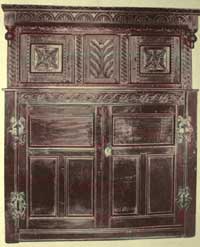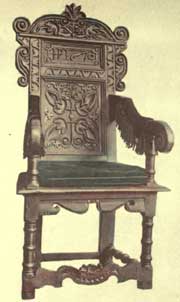Stuart Furniture Style
The Stuart style is sometimes named Jacobean, and is a term designating the furniture of almost a century (1603-1690). A more rigorous approach is using the term “Stuart furniture” for the furniture of this entire period, while dividing it as follows:
- - The Jacobean style proper: the reigns of James I (1603-1625) and Charles I (1625-1649).
- - The Commonwealth, or Cromwellian style (1653-1659).
- - The Restoration, with the reigns of Charles II (1660-1685) and James II (1685-1689).
The Stuart period can also be divided according to the wood used in making the furniture, and, about 1660, we may say that the walnut age began.

Stuart Cabinet, oak
In the beginning, the Stuart style was still influenced by the carved oak style of the Elizabethan period. However, the Gothic ornaments slowly disappeared from the Elizabethan mixture of Renaissance and Gothic elements.
The Stuart period style was a result of the traditional English furniture being modified by continental influences, especially Dutch, which led to a great diversity of forms. The early Stuart or Jacobean furniture is characterized by the simplicity of straight lines defining massive, solid pieces.
Cupboards and dressers were rather short, and even the bedsteads, with their carved testers and heavy posts, were lower than images are suggesting.
The cabinets of the Stuart period kept their forms up to the Cromwellian era when they became longer. The ball foot was introduced, being used on cupboards and chests. The chests of drawers also became more common.
In the early Stuart times, chairs were still reserved only for important persons, thus they were not so numerous. During the Stuart period, chairs will show a progressive development of forms, and their numbers increased. The chairs had mainly high square seats, stretchers between the legs, and high backs. Because of the high seats, footboards were used. Open backs chairs (Yorkshire and Derbyshire type) appeared just before the Commonwealth period.
The Stuart style chairs were more numerous during the Commonwealth than in the previous epochs, as the persons of lower rank were now permitted to use the same type of chairs as the masters. The chairs had a lower back, turned legs, stretchers, the seat and the upper part of the back being upholstered with leather. As ornamentation, the knobbed turning of stretchers and legs was heavily used.
Stuart furniture carving was revived during the Restoration. The number of open backs chairs increased. The back was caned, or with balusters or slats. The arm-rests became curved, and the back rails also had a slightly curved shape. The spiral turned legs used for tables and chairs came into vogue, together with the walnut, which was more suited to delicate carving.
Towards the end of the period, the Stuart chairs and sofas had the seats and the high square backs upholstered with fabrics in vivid colors, with “Flemish” scrolled legs.
The last type of Stuart furniture chairs had an almost vertical high caned or baluster back, using the same elaborated Flemish scrolled legs.

